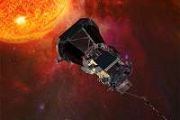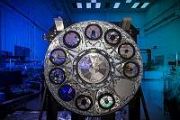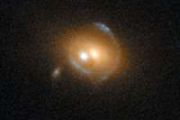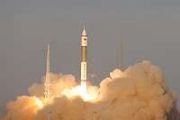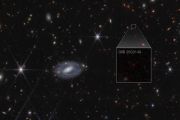
Copernical Team
NASA issues award for greener, more fuel-efficient airliner of future
 NASA announced Wednesday it has issued an award to The Boeing Company for the agency's Sustainable Flight Demonstrator project, which seeks to inform a potential new generation of green single-aisle airliners.
Under a Funded Space Act Agreement, Boeing will work with NASA to build, test, and fly a full-scale demonstrator aircraft and validate technologies aimed at lowering emissions.
NASA announced Wednesday it has issued an award to The Boeing Company for the agency's Sustainable Flight Demonstrator project, which seeks to inform a potential new generation of green single-aisle airliners.
Under a Funded Space Act Agreement, Boeing will work with NASA to build, test, and fly a full-scale demonstrator aircraft and validate technologies aimed at lowering emissions. Visibility of stars in the night sky declines faster than previously thought
 People around the world are seeing fewer and fewer stars in the night sky. The change in star visibility can be explained by an increase in the sky brightness of 7-10 percent per year. The rate of change is faster than satellite measurements of artificial light emissions on Earth would at first suggest.
This is the finding of a study published in the journal Science, conducted by a researc
People around the world are seeing fewer and fewer stars in the night sky. The change in star visibility can be explained by an increase in the sky brightness of 7-10 percent per year. The rate of change is faster than satellite measurements of artificial light emissions on Earth would at first suggest.
This is the finding of a study published in the journal Science, conducted by a researc China to launch 200-plus spacecraft in 2023
 The China Aerospace Science and Technology Corporation (CASC) plans to launch more than 200 spacecraft with over 60 space missions in 2023, according to a company report released Wednesday.
The CASC report unveiled plans for the country's space science and technology activities in 2023. It said that the Tianzhou 6 cargo craft, the Shenzhou XVI and the Shenzhou XVII flight missions would ta
The China Aerospace Science and Technology Corporation (CASC) plans to launch more than 200 spacecraft with over 60 space missions in 2023, according to a company report released Wednesday.
The CASC report unveiled plans for the country's space science and technology activities in 2023. It said that the Tianzhou 6 cargo craft, the Shenzhou XVI and the Shenzhou XVII flight missions would ta Eutelsat successfully decommissions EUTELSAT 5 West A satellite
 Initially designed for a 15-year lifetime, the EUTELSAT 5 West A satellite has retired after an impressive 20+ years of fruitful in-orbit operation. The satellite was successfully re-orbited as planned to more than 400km above the geostationary arc, the propulsion system depressurised and the electrical equipment on board passivated. The final operation to de-activate the remaining Radio Frequen
Initially designed for a 15-year lifetime, the EUTELSAT 5 West A satellite has retired after an impressive 20+ years of fruitful in-orbit operation. The satellite was successfully re-orbited as planned to more than 400km above the geostationary arc, the propulsion system depressurised and the electrical equipment on board passivated. The final operation to de-activate the remaining Radio Frequen Microchip radiation-tolerant power management devices will target LEO applications
 The commercialization of the Low-Earth Orbit (LEO) region is transforming space exploration and satellite communication at roughly 1,200 miles above Earth. For satellites to successfully operate and reach their destination, it is essential to select components that can withstand the harsh space environment.
Building on its existing radiation-tolerant portfolio, Microchip Technology Inc. (N
The commercialization of the Low-Earth Orbit (LEO) region is transforming space exploration and satellite communication at roughly 1,200 miles above Earth. For satellites to successfully operate and reach their destination, it is essential to select components that can withstand the harsh space environment.
Building on its existing radiation-tolerant portfolio, Microchip Technology Inc. (N Hera's time of trial
 One of last year's space highlights was the NASA DART mission's collision with Dimorphos (seen right), the small moon of the binary asteroid Didymos (seen left). The impact which measurably shifted the target asteroid's orbit around its primary while casting a plume of debris thousand of kilometres out into space.
Next comes ESA's Hera spacecraft which will return to the binary asteroid to
One of last year's space highlights was the NASA DART mission's collision with Dimorphos (seen right), the small moon of the binary asteroid Didymos (seen left). The impact which measurably shifted the target asteroid's orbit around its primary while casting a plume of debris thousand of kilometres out into space.
Next comes ESA's Hera spacecraft which will return to the binary asteroid to Our Encanto: Sols 3716-3717
 Yesterday's plan executed successfully including a short bump that placed us in front of an interesting block that may just contain our next drilled target!
Before the science team commits to drilling the target "Encanto," we will first investigate the chemistry and composition of the target using APXS, ChemCam, and Mastcam (using their multispectral capability), to ensure that it is scien
Yesterday's plan executed successfully including a short bump that placed us in front of an interesting block that may just contain our next drilled target!
Before the science team commits to drilling the target "Encanto," we will first investigate the chemistry and composition of the target using APXS, ChemCam, and Mastcam (using their multispectral capability), to ensure that it is scien Researches on Chang'e 5 lunar samples gain fruitful results
 More than 50 research results on the lunar samples brought back by the Chang'e-5 mission have been published in notable academic journals at home and abroad, pushing China's lunar science research to the international forefront, according to the China National Space Administration (CNSA).
Over 150 scientists and researchers participated in the first Chang'e-5 Lunar Sample Research Results
More than 50 research results on the lunar samples brought back by the Chang'e-5 mission have been published in notable academic journals at home and abroad, pushing China's lunar science research to the international forefront, according to the China National Space Administration (CNSA).
Over 150 scientists and researchers participated in the first Chang'e-5 Lunar Sample Research Results ALUULA Composites selected for future Mars missions
 ALUULA Composites, a new advanced materials technology firm is pleased to report that its ultralight and strong composite materials have been selected by Thin Red Line Aerospace for future NASA missions.
ALUULA is supporting Thin Red Line Aerospace's development of cutting-edge, critical application hardware for future NASA lunar and Mars missions. "Their unique range of technical attribut
ALUULA Composites, a new advanced materials technology firm is pleased to report that its ultralight and strong composite materials have been selected by Thin Red Line Aerospace for future NASA missions.
ALUULA is supporting Thin Red Line Aerospace's development of cutting-edge, critical application hardware for future NASA lunar and Mars missions. "Their unique range of technical attribut Stars disappear before our eyes, citizen scientists report
 A startling analysis from Globe at Night - a citizen science program run by NSF's NOIRLab - concludes that stars are disappearing from human sight at an astonishing rate. The study finds that, to human eyes, artificial lighting has dulled the night sky more rapidly than indicated by satellite measurements. The study published in the journal Science showcases the unique contributions that citizen
A startling analysis from Globe at Night - a citizen science program run by NSF's NOIRLab - concludes that stars are disappearing from human sight at an astonishing rate. The study finds that, to human eyes, artificial lighting has dulled the night sky more rapidly than indicated by satellite measurements. The study published in the journal Science showcases the unique contributions that citizen 





